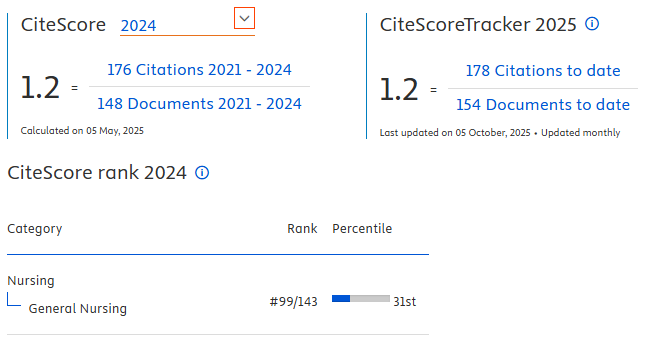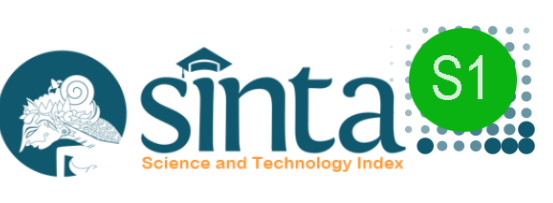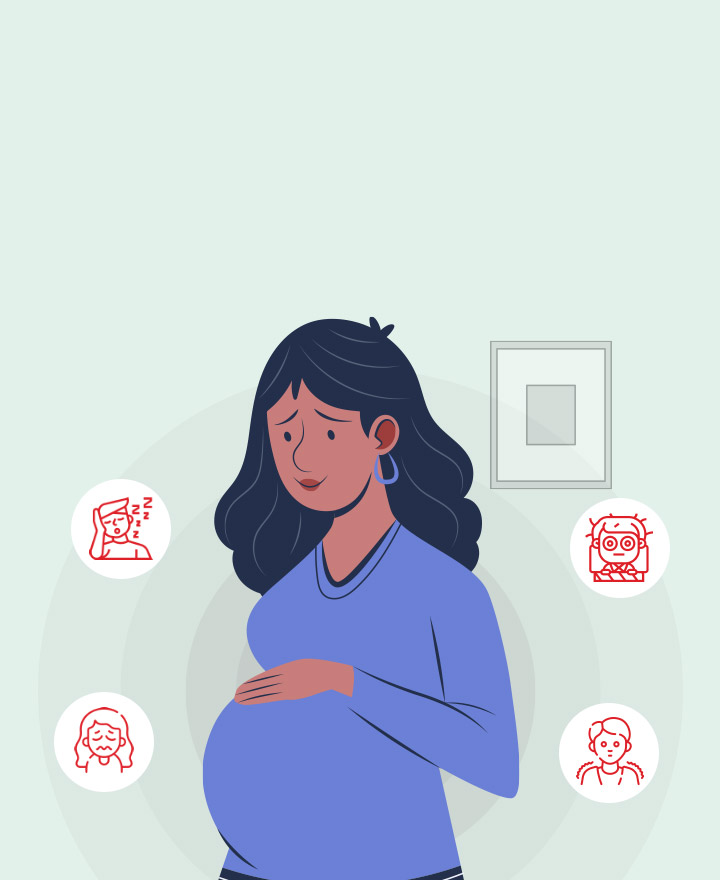Psychometric validation of Filipino versions of the survey of attitudes toward statistics and attitudes toward research for nursing students

Downloads
Introduction: Despite the recognized importance of assessing nursing students' attitudes toward statistics and research, no validated instruments exist specifically for the Filipino context. This study aimed to evaluate the psychometric properties of the Filipino adaptations of the Survey of Attitudes toward Statistics (SATS-F) and Attitudes toward Research (ATR-F) scales.
Methods: A quantitative cross-sectional survey design, using convenience sampling, was employed to collect data from August to October 2022. Participants were Filipino nursing students taking nursing research and statistics courses who were at least 18 years old. Participants with >10% incomplete data on any instrument were excluded.
Results: Descriptive statistics showed mean scores ranging from 4.45 to 6.10 for ATR-F items and 2.88 to 5.55 for SATS-F items. A strong content validity was demonstrated, with S-CVI/Ave values of 0.94 for ATR-F and 0.98 for SATS-F. Principal Component Analysis (PCA) showed 75.3% of the cumulative explained variance for ATR-F and 61.9% for SATS-F. Pearson correlation analysis further supported construct validity, revealing a significant positive relationship (r = 0.50, p < 0.001) between ATR-F and SATS-F, which indicates a strong association between nursing students' attitudes toward research and statistics. Internal consistency reliability was established, with Cronbach's alpha coefficients of 0.87 for ATR-F and 0.90 for SATS-F.
Conclusions: SATS-F and ATR-F possess sound psychometric properties, rendering them reliable tools for assessing Filipino nursing students' attitudes toward statistics and research. Educators and researchers can use these culturally adapted and validated instruments to develop targeted interventions to enhance nursing students' preparedness for research-informed practice.
Ajzen, I. and Fishbein, M. (2000) Attitudes and the Attitude-Behavior Relation: Reasoned and Automatic Processes’, European Review of Social Psychology, 11(1). Available at: https://doi.org/10.1080/14792779943000116.
Al Furaikh, S., Al Omairi, B. and Ganapathy, T. (2017) ‘A cross-sectional survey on nursing students’ attitude towards research’, Journal of Health Specialties, 5(4). Available at: https://doi.org/10.4103/jhs.jhs_36_17.
Ayaz-Alkaya, S., & Terzi, H. (2024). Effectiveness of scientific research education programme on the attitudes of nursing students towards research methods course: a pre and post-implementation study. Contemporary Nurse, 1–9. https://doi.org/10.1080/10376178.2024.2310265
Ayebo, A., Bright, J. and Ballam, C. (2019) ‘Examining the Factor Structure of the Survey of Attitudes Towards Statistics among Undergraduate Health Science Students’, International Electronic Journal of Mathematics Education, 15(1). Available at: https://doi.org/10.29333/iejme/5942.
Beaton, D.E. et al. (2000) ‘Guidelines for the process of cross-cultural adaptation of self-report measures’, Spine. Available at: https://doi.org/10.1097/00007632-200012150-00014.
Bindler, R. J., & Saul, T. (2023). Stats lab: Piloting live digital statistics learning modules for nurses at a multicenter health institution in the Western United States. Teaching and Learning in Nursing. https://doi.org/10.1016/j.teln.2023.07.011.
De Becerra, G.M.A. et al. (2020) ‘Attitudes towards Research Scale (ATRS): Evaluation of its psychometric properties in a Colombian Sample’, Revista CES Psicologia, 13(1). Available at: https://doi.org/10.21615/CESP.13.1.6.
Chiesi, F. and Primi, C. (2009) ‘Assessing statistics attitudes among college students: Psychometric properties of the Italian version of the Survey of Attitudes toward Statistics (SATS)’, Learning and Individual Differences, 19(2), pp. 309–313. Available at: https://doi.org/10.1016/j.lindif.2008.10.008.
Comrey, A.L., & Lee, H.B. (1992). A first course in factor analysis (2nd ed.). Hillsdale, NJ: Lawrence Erlbaum Associates.
Connor, L. et al. (2023) ‘Evidence-based practice improves patient outcomes and healthcare system return on investment: Findings from a scoping review’, Worldviews on Evidence-Based Nursing. Available at: https://doi.org/10.1111/wvn.12621.
Costello, A.B. and Osborne, J.W. (2005) ‘Best practices in exploratory factor analysis: Four recommendations for getting the most from your analysis’, Practical Assessment, Research and Evaluation, 10(7).
Douglas, S.P. and Craig, C.S. (2007) ‘Collaborative and iterative translation: An alternative approach to back translation’, Journal of International Marketing. Available at: https://doi.org/10.1509/jimk.15.1.030.
Eagly, A.H. and Chaiken, S. (2007) ‘The advantages of an inclusive definition of attitude’, Social Cognition, 25(5). Available at: https://doi.org/10.1521/soco.2007.25.5.582.
García-Martínez, J. A., Fallas-Vargas, M. A., & Romero-Hernández, A. (2015). Las actitudes hacia la estadística del estudiantado de orientación. Revista Electronic@ Educare, 19(1), 25–41. https://doi.org/10.15359/REE.19-1.2
Hagen, B. et al. (2013) ‘Evaluation of undergraduate nursing students’ attitudes towards statistics courses, before and after a course in applied statistics’, Nurse Education Today, 33(9), pp. 949–955. Available at: https://doi.org/10.1016/j.nedt.2012.11.005.
Ilhan, N. (2021). The Effect of Research Evidence-Based Teaching Practices in Science Classrooms on Student Teachers’ Attitudes towards Educational Research. Journal of Science Learning. 4(4), 316–326. https://doi.org/10.17509/JSL.V4I4.32025
Kakupa, P. and Xue, H. (2019) ‘Students’ Attitudes towards Research: A Study of Graduate Education Students at a Chinese Normal University’, Educational Process: International Journal, 8(2), pp. 97–110. Available at: https://doi.org/10.22521/edupij.2019.82.1.
Kaufmann, L. et al. (2022) ‘Self-efficacy matters: Influence of students’ perceived self-efficacy on statistics anxiety’, Annals of the New York Academy of Sciences, 1514(1), pp. 187–197. Available at: https://doi.org/10.1111/nyas.14797.
Khan, K.A. et al. (2021) ‘Construction and Piloting of Attitude Towards Research Participation Scale for University Students’, Psychology Research and Behavior Management, 14, pp. 2071–2079. Available at: https://doi.org/10.2147/PRBM.S333450.
Khavenson, T., Orel, E. and Tryakshina, M. (2012) ‘Adaptation of Survey of Attitudes Towards Statistics (SATS 36) for Russian Sample’, Procedia - Social and Behavioral Sciences, 46, pp. 2126–2129. Available at: https://doi.org/10.1016/j.sbspro.2012.05.440.
Kiekkas, P. et al. (2015) ‘Nursing students’ attitudes toward statistics: Effect of a biostatistics course and association with examination performance’, Nurse Education Today, 35(12), pp. 1283–1288. Available at: https://doi.org/10.1016/j.nedt.2015.07.005.
Lynn, M. (1986) ‘Determination and Quantification of Content Validity’, Nursing Research [Preprint].
Maas, L., Brinkhuis, M. J. S., Kester, L., & Wijngaards-de Meij, L. (2022). Cognitive Diagnostic Assessment in University Statistics Education: Valid and Reliable Skill Measurement for Actionable Feedback Using Learning Dashboards. Applied Sciences, 12(10), 4809. https://doi.org/10.3390/app12104809
MacCallum, R.C., Widaman, K.F., Zhang, S., & Hong, S. (1999). Sample size in factor analysis. Psychological Methods, 4(1), 84–99.
Nolan, M.M., Beran, T. and Hecker, K.G. (2012) ‘Surveys assessing students’ attitudes toward statistics: A systematic review of validity and reliability’, Statistics Education Research Journal, 11(2). Available at: https://doi.org/10.52041/serj.v11i2.333.
Norris, P. and Epstein, S. (2011) ‘An experiential thinking style: Its facets and relations with objective and subjective criterion measures’, Journal of Personality, 79(5), pp. 1043–1080. Available at: https://doi.org/10.1111/j.1467-6494.2011.00718.x.
Nunnally, J.C. and Bernstein, I.H. (1994) Psychometric theory. 3rd edn, Philosophical Magazine. 3rd edn. New York: McGraw Hill.
Oducado, R.M.F. (2021) ‘Factors Affecting Nursing Students’ Attitude Towards Research: A Survey in a Philippine Higher Education Institution’, Jurnal Ilmiah Ilmu Keperawatan Indonesia, 11(01). Available at: https://doi.org/10.33221/jiiki.v11i01.956.
de Oliveira Júnior, A.P. et al. (2018) ‘Student’s Attitudes Towards Probability and Statistics and Academic Achievement on Higher Education’, Acta Didactica Napocensia, 11(2), pp. 43–56. Available at: https://doi.org/10.24193/adn.11.2.4.
Padagas, R.C. and Hajan, B.H. (2020) ‘Academic reading and writing needs of undergraduate nursing students in research’, International Journal of Learning, Teaching and Educational Research, 19(5), pp. 318–335. Available at: https://doi.org/10.26803/ijlter.19.5.20.
Papanastasiou, E.C. (2014) A First Look at its Psychometric Properties, Attitudes Toward Research Scale (R-ATR.
Polit, D.F. and Beck, C.T. (2006) ‘The content validity index: Are you sure you know what’s being reported? Critique and recommendations’, Research in Nursing and Health, 29(5), pp. 489–497. Available at: https://doi.org/10.1002/nur.20147.
Rammstedt, B., Danner, D. and Bosnjak, M. (2017) ‘Acquiescence response styles: A multilevel model explaining individual-level and country-level differences’, Personality and Individual Differences, 107. Available at: https://doi.org/10.1016/j.paid.2016.11.038.
Rind, Z. (2020) ‘Attitude of students towards research: A review’, International Journal of Multidisciplinary Research and Development, 7(5), pp. 101–102. Available at: www.allsubjectjournal.com.
Roberts, D.M. and Bilderback, E.W. (1980) ‘Reliability and validity of a statistics attitude survey’, Educational and Psychological Measurement, 40(1), pp. 235–238. Available at: https://doi.org/10.1177/001316448004000138.
Sarikaya, E.E. et al. (2018) ‘Turkish version of the survey of attitudes toward statistics: Factorial structure invariance by gender’, International Journal of Higher Education, 7(2). Available at: https://doi.org/10.5430/ijhe.v7n2p121.
Schau, C., Stevens, J. J., Dauphinee, T. L., & Del Vecchio, A. (1995). The development and validation of the Survey of Attitudes toward Statistics. Educational and Psychological Measurement, 55(5), 868–875. https://doi.org/10.1177/0013164495055005022
Schreiber, J. B., & Turk, M. T. (2022). Statistics and Data Analysis Literacy for Nurses. https://doi.org/10.1891/9780826165824
Sin & Rosli (2020) ‘Validity and Reliability of the Survey of Attitudes Toward Statistics (SATS) Instrument (Kesahan dan Kebolehpercayaan Instrumen Survey of Attitudes Toward Statistics (SATS)’, Jurnal Pendidikan Malaysia, 45(01SI), pp. 17–24. Available at: https://doi.org/10.17576/jpen-2020-45.01si-03.
Stanisavljevic, D. et al. (2014) ‘Assessing attitudes towards statistics among Medical students: Psychometric properties of the Serbian Version of the survey of attitudes towards statistics (SATS)’, PLoS ONE. Public Library of Science. Available at: https://doi.org/10.1371/journal.pone.0112567.
Tabachnick, B.G. and Fidell, L.S. (2007) ‘Using multivariate statistics (5th ed.)’, Using multivariate statistics [Preprint], (April).
Tempelaar, D.T., Schim Van Der Loeff, S. and Gijselaers, W.H. (2007) ‘A Structural Equation Model Analyzing the Relationship of Students’ Attitudes Toward Statistics, Prior Reasoning Abilities and Course Performance’, Statistics Education Research Journal, 6(2), pp. 78–102. Available at: http://www.stat.auckland.ac.nz/serj.
Tran-Chi, V.-L. (2019) ‘Exploring Vietnamese Psychology Undergraduates’ Attitudes towards Research’, International Journal of Educational Sciences, 25(1–3), pp. 51–57. Available at: https://doi.org/10.31901/24566322.2019/25.1-3.1082.
Vanhoof, S., Kuppens, S., Elisa, A., et al. (2011) Measuring Statistics Attitudes: A Structure of the Survey of Attitudes Towards Statistics (SATS-36). Aukland. Available at: http://www.evaluationandstatistics.com/index.html.
Vanhoof, S., Kuppens, S., Sotos, A.E.C., et al. (2011) ‘Measuring statistics attitudes: Structure of the survey of attitudes toward statistics (SATS-36)’, Statistics Education Research Journal, 10(1). Available at: https://doi.org/10.52041/serj.v10i1.354.
Vrikki, M., & Papanastasiou, E. C. (2024). Research attitudes among pre-service teachers: unexpected outcomes emerging from a natural experiment. Journal of Applied Research in Higher Education. https://doi.org/10.1108/jarhe-07-2023-0282
Wise, S.L. (1985) ‘The Development and Validation of a Scale Measuring Attitudes toward Statistics’, Educational and Psychological Measurement, 45(2), pp. 401–405. Available at: https://doi.org/10.1177/001316448504500226.
Woltenberg, L. N. (2021). Cultivating Statistical Literacy Among Health Professions Students: a Curricular Model. Medical Science Educator, 31(2), 417–422. https://doi.org/10.1007/S40670-021-01256-4
Wongvorachan, T., Srisuttiyakorn, S., & Sriklaub, K. (2024). Optimizing Learning: Predicting Research Competency via Statistical Proficiency. Trends in Higher Education, 3(3), 540–559. https://doi.org/10.3390/higheredu3030032
Copyright (c) 2025 Jurnal Ners

This work is licensed under a Creative Commons Attribution 4.0 International License.
Authors who publish with Jurnal Ners agree to the following terms:
- Authors transfer the Copyright and grant Jurnal Ners the right of first publication with the work simultaneously licensed under a Creative Commons Attribution 4.0 International License that allows others to remix, adapt and build upon the work with an acknowledgment of the work's authorship and of the initial publication in Jurnal Ners.
- Authors are permitted to copy and redistribute the journal's published version of the work (e.g., post it to an institutional repository or publish it in a book), with an acknowledgment of its initial publication in Jurnal Ners.
Jurnal Ners requires a formal written declaration and transfer of copyright from the author(s) for each article published. We, therefore, ask you to complete and return this form, retaining a copy for your own records. Your cooperation is essential and appreciated. Any delay will result in a delay in publication. The form can be downloaded HERE.
































